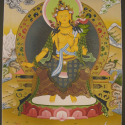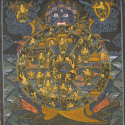Description
Maitreya Buddha with Padmasambhava Painting is hand-painted on Cotton Canvas in Kathmandu, Nepal. Maitreya represents the future state of love emanating. This is embodied by the Adi Buddha Samantabhadra & gained by using the tools of Vajrayana ‘magical’ Buddhism & can be realized from the adamantine truth of emptiness embodied by Adi Buddha Vajradhara.
Maitreya Buddha is presented at the center of the thangka. Padmasambhava is presented at the top right corner of the Maitreya Buddha in the painting. Lama Teacher is presented at the top left corner of the Maitreya Buddha in the painting.
Gren Tara is presented at the bottom left corner of the Maitreya Buddha in the painting. White Tara is presented at the bottomright corner of the Maitreya Buddha in the painting.
Iconography of Maitreya Buddha
He holds both hands in front of his heart in a hand position signifying the turning of the wheel of Buddhist teachings. The left hand holds the stem of a blue lotus or ‘night lotus’. The word Utpala means to ‘burst open’.
This supports an auspicious golden wheel that represents change, universal cycles of existence such as the changing of the hands of a watch, the seasons of the year, the earth & moon revolving around the sun, and these three, in turn, revolving with other planets. The right hand holds another lotus stem supporting a water pot which traditionally contains the primeval water carried by the creator Brahma.
This water of creation or water of life don’t confuse with the blue nectar of immortality]represents the pure conscious mind and its ability to regenerate and purify the conscious mind. The water pot is one of the eight auspicious symbols where the word Asta means eight. The green nimbus around his head represents his cosmic nature.
He is surrounded by a blooming ‘pink lotus’ and an unopened bud on her left hand. The Pink lotus blossoms represent the present love and the red unopened bud future love & yet to be born Buddhas. The future here also refers to beneficial changes circumstances that will help bring them about.
Maitreya’s elongated earlobes represent patience; his topknot his abandonment of worldly possessions, the dot on his brow on the command chakra represents his transcendent wisdom. The thin blue aureole around his body signifies the highest level of understanding.
Iconography of Green Tara
Gren Tara is presented at the bottom left corner of the Maitreya Buddha in the painting. She is shown with a benevolent countenance seated upon a white moon disk which is associated with special restorative nectar associated with the naval chakra center. In Buddhists, the moon symbolizes the wisdom aspect which when coupled with compassion leads to Sakyamuni Buddha’s enlightenment. Her right hand is gracefully lowered in Varada mudra, the boon-granting gesture.
Green Tara’s special lotus is the blue lotus or ‘night lotus’ which she bears in both hands. The word Utpala means to ‘burst open’. Her left hand holds a stem with an open blooming flower and an unopened bud. The bent lower part of the stem represents the root.
The open blossom represents the present and also the present Buddha; the bud represents the future and also Buddhas yet to be born. The future here also refers to a safe journey’s end and future well-being. Her right-hand wisdom hand is in the gesture of giving refuge.
The third finger touches the thumb to create a circle representing the union of wisdom and compassion, and the three extended fingers symbolize the Three Jewels of Buddhism a. The Buddha State b. The Body of teachings c.
The Principles of the Universe The same hand holds the stem of a blue lotus representing her willingness to assist. The closed blossom in her right hand represents the past and also the Buddhas of the past. Green Tara is shown in a place of paradise called Khadiravani where Tara dwells. Khadiravani is described as a great mountain kingdom with many trees, flowers, and animals rainbow tails emanating from her outer aureole. The crescent moon and sun symbolize the union of males and females ubiquitous in Tantric art.
Mantra of Green Tara
The mantra of Green Tara is om tare tuttare ture soha.
Iconography of White Tara
White Tara is presented at the bottom right corner of the Maitreya Buddha in the painting. White Tara’s embodiment of peace is directed through loving compassion. From her serenity, she lends grace and dignity to situations and encourages the good to arise in all circumstances and situations.
The extra eye on her forehead, on the palms of her hands & the soles of her feet, represent her ability to see and understand the sufferings of all beings & her omniscient compassion toward the suffering.
Mantra of White Tara
The mantra of White Tara is Om Tare Tuttare Ture Mama Ayur Pune Gyana Puntin Kuru Swoha.
Iconography of Padmasambhava
Padmasambhava is presented at the top right corner of the Maitreya Buddha in the painting. The Khatvanga, a danda with three severed heads denoting the three kayas (the three bodies of a Buddha: the dharmakaya, sambhogakaya, and nirmanakaya), crowned by a Trishula and dressed in a sash of the Himalayan Rainbow or Five Pure Lights of the Mahabhuta is a particular divine attribute of Padmasambhava and intrinsic to his iconographic representation.
His two eyes are wide open in a piercing gaze. On his body, he wears a white vajra undergarment and, on top of this, in layers, a red robe, a dark blue Mantrayana tunic, a red monastic shawl decorated with a golden flower pattern, and a maroon cloak of silk brocade. He has one face and two hands.
In his right hand, he holds a five-pronged vajra at his heart; and in his left, which rests in the gesture of equanimity, he holds a skull-cup in the center of which is a vase of longevity filled with the nectar of deathless wisdom. Cradled in his left arm is a three-pointed Khatvanga representing the consort Mandarava. On his head, he wears a five-petalled lotus hat.
Wrathful and smiling, he blazes magnificently with the splendor of the major and minor marks. He is seated with his two feet in the royal posture.
Mantra of Padmasambhava
The mantra of Padmasambhava is Om Ah Hum Vajra Guru Padma Siddhi Hum.












































Reviews
There are no reviews yet.